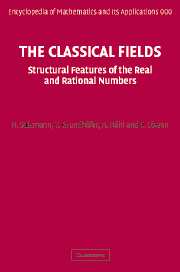Preface
Published online by Cambridge University Press: 07 May 2010
Summary
The rational numbers, the real numbers, the complex numbers and the p-adic numbers are classical fields. These number systems are the topic of this book.
The real numbers, which are basic and indispensable for most parts of mathematics, comprise several rich and intimately interwoven structures, namely the algebraic structure as a field, the topological structure and the ordering structure. Each of these structures, as well as their particular blend, is beautifully adapted to the intended use of numbers (for counting, computing, taking measurements, comparing sizes and modelling physical space and time). It is the purpose of this book to consider these structures separately, and to analyse the interaction and the interdependencies between these structures. The real numbers are characterized in various categories by simple abstract properties. Each of these characterization results is a possible answer to the question: why exactly are the real numbers so fundamentally important?
The ordering and the topology of the real numbers are rooted deeply in our geometric intuition about points on a line. The algebraic operations of addition and multiplication describe the isometries and the similarities of the one-dimensional geometry of a line. (In fact, one-dimensional geometry becomes interesting only by imposing some additional structure on the set of points of the only line.)
Apart from the real numbers, we also treat the rational numbers (in Chapter 3) and the p-adic numbers (in Chapter 5). The complex numbers are considered in Section 14 (to some extent also in Section 13), and Chapter 2 deals with non-standard numbers. We study the structural components of each of these fields and their interactions; we also describe the pertaining automorphism groups and typical substructures and quotients.
- Type
- Chapter
- Information
- The Classical FieldsStructural Features of the Real and Rational Numbers, pp. ix - xiiPublisher: Cambridge University PressPrint publication year: 2007



